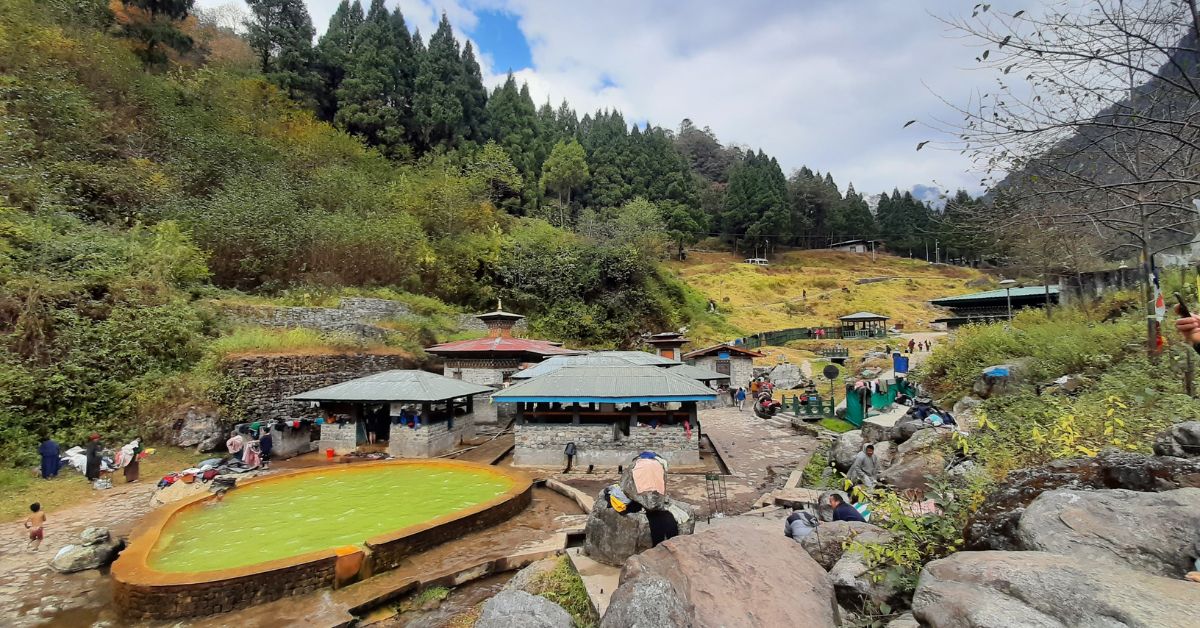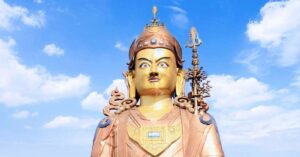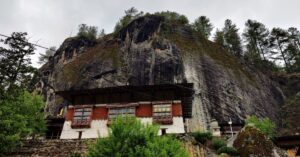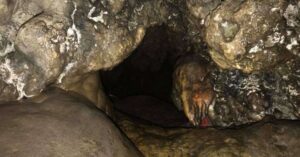Gasa Tshachu is a hot spring believed to cure 13 different diseases known as Neyrig Chusum. It is one of the most popular hot springs in Bhutan and is situated near the bank of the Mo Chhu River at an elevation of 2100 meters in Gasa Dzongkhag.
However, the 2021 flood caused by a swollen Mochhu wiped away the hot spring. It was only reopened to the public following two years of reconstruction on October 14, 2023.
The Gasa Tshachu, or the Gasa hot spring, is extremely popular nationwide for its healing powers. Other popular hot springs in Bhutan are the Chubu hot spring and Koma hot spring in Punakha; the Gelephu hot spring in Sarpang; the Duenmang hot spring in Zhemgang; and the Khempajong nye hot spring in Lhuntse.
Also Read: Hot Springs in Bhutan: Bhutanese Beliefs and Benefits
How to Reach Gasa Tshachu
Gasa is roughly 47 kilometers from Punakha and 134 kilometers from Thimphu. From Punakha, it takes about two hours to drive to Gasa Tshachu. If you travel from Gasa Dzong, it is around 2 km. There is a blacktopped road that takes you right there to the hot spring.
However, given the state of the roads, it is advised to drive a light or medium-sized car. You must rent a car or drive your vehicle because no public transportation is available.
Trek Route of Gasa Tsachu
- Start from Bajo town, Punakha;
- Bajo to Gasa Hot Spring: 40 km and a 2-hour drive by car.
Also Read: How to Trek to Dur Hot Spring in Bumthang
The Origin of Gasa Tshachu
The origin of the Gasa hot spring dates back to the time of Drubthob Terkhungpa in the 13th century. According to history, the Gasa hot spring originated when Drupthop Terkhungpa dispersed 128 different types of medicines throughout Gasa, from which 128 hot springs, also known as Tshachu, and medicinal springs, also known as Menchu, originated.
Later, when Zhabdrung Ngawang Namgyel came to Bhutan in 1616, he entered through Gasa. He spent a few days at Gasa Tshachu before traveling to Punakha with his followers and supporters. The hot spring has alleviated Zhabdrung’s severe joint pain and exhaustion. He, therefore, gave a blessing to Gasa Tsachu to remain forever to benefit all sentient beings.
Also Read: The Origin of Koma Tshachu, a Hot Spring of Guru Rinpoche at the base of Ney Rinchen Dzong
Description of Gasa Tsachu
The overall area of the Gasa Tshachu and the guesthouse occupies 24 acres. The hot spring is open 24/7 with a power supply.
The new-look Gasa hot spring Tshachu now boasts 10 ponds featuring an open layout design with uniquely designed ponds and sheds. The 8 Ponds in two C-shaped sheds are for the public, and the other two ponds, one pond each in the two sheds, are for the VIPs.
The two C-shaped sheds are allocated separately for males and females, with four ponds each for men and women. The C-shaped shed with four ponds can accommodate 100, with each pond accommodating about 25 people. In total, the two sheds for the public can accommodate around 180-200 men and women.
Visitors can choose the pool according to their preferences, as the temperature of Gasa Tshachu varies in each pool with different medicinal values. The hot spring temperature is said to be the same as before at the source. But since the current ponds are a bit far from the source, the hot spring temperature in the ponds is a little lower compared to previous ponds.
The shower facilities, dressing rooms, and public toilets are built near the hot spring structures to ensure that Gasa Tshachu remains clean and hygienic. To accommodate the needs of senior guests, shoes and slippers are kept out of the way of the ponds. Features like non-slip surfaces and easily accessible steps make the ponds accessible to the elderly. There is also an outdoor pool.
Nevertheless, the location lacks stores, restrooms, and accommodations for individuals with disabilities.
Also Read: Description of Gelephu Tshachu
Therapeutic Values or Ethnopharmacological Benefits of Gasa Tshachu
Gasa Tshachu is believed to be a site where the medicine thrown by Terkhungpa has landed. Therefore, the hot spring is said to have healing properties for several diseases. Precisely, the Tshachu is believed to cure thirteen different types of diseases, which are referred to as Neyrig Chusum.
The water gives a sulfuric smell, which is supposed to have a healing effect. The hot spring is thought to treat digestion problems, joint pain, arthritis, ulcers, rheumatism, indigestion, tuberculosis, and skin diseases. In addition, it cures colds, gout, lymphatic disorders, fractures, and poisoning-related illnesses. There are several accounts of people being cured of various chronic illnesses. But the results appear only after soaking in the waters for a lengthy time.
However, pregnant women and those with high blood pressure, neurological disorders, malaria, or jaundice should avoid it.
Also Read: Therapeutic Values or Ethnopharmacological Benefits of Duenmang Tshachu
Menchu
There are many Menchu or medicinal springs near the Gasa hot spring. One such is the Yama Menchu or medicinal spring, located just above the hot spring. While Gama Menchu is to the right, Gasa Jagay Menchu is located to the left of Gasa Tshachu.
Also Read: Menchu or Medicinal Springs in Bhutan: Beliefs and Benefits
Accommodation at Gasa Tshachu
The Gasa Dzongkhag Administration has upgraded the accommodation facilities at the Gasa Tshachu Guest House for enhanced comfort and convenience. With this initiative, the accommodation rate was also revised with effect from 1st July 2025.
Accommodation options:
1. Executive Accommodation-Guest House Type A
Rate Nu. 2000/night.
Amenities provided: They provide two rooms with one double-size mattress for a king-size bed, one single-size mattress, blankets, and basic kitchen facilities (one rice cooker, one curry cooker, and one boiler). The toilet has a geyser.
2. Guest House Type B
Rate Nu. 800/night.
Amenities provided: They provide two rooms with one double-size mattress, one single-size mattress, kitchen utensils, one rice cooker, one curry cooker, and one boiler. The room has a toilet and a kitchen table with water inside. The rooms can accommodate 7 people.
3. Guest House Type C
Rate Nu. 300/night.
Amenities provided: They provide only one room with two single-size mattresses. The room has a common toilet. It can accommodate 7 people.
You have to bring your cooking items in case of the Guest House types B and C.
There are four shops in the Tshachu compound run by the locals. But the cost of food is very expensive, and the choice of food is limited. So, if you are planning to stay in the Tshachu guest house, we recommend you bring enough food items.
Also Read: Chubu Tshachu, the Hot Spring of Guru Rinpoche in Punakha
Tshachu online room booking
Gasa Tshachu contact number: You can contact the Manager of Gasa Tshachu, Tandin Dorji, for any services at 16288150, and Ugyen Rinzin at 17110638 for accommodation reservations.
Best Time to Visit Gasa Tshachu
The Gasa Hot Spring is now more easily accessible to tourists because of road connectivity. Winter is the ideal time of year to explore the Gasa hot spring. But Gasa Tshachu will be busy from December to March. The moderate weather during this time of the year is another factor for swelling crowds in the hot spring. Therefore, getting to the pool would be very difficult as people line up in the queue and take turns. The accommodation will also be a problem.
Therefore, it is also an excellent time to visit the Gasa hot spring in the autumn when the trees and grasslands change color. It’s much better to go in the spring when the trees and flowers start to blossom. This is due to age-old wisdom that says therapeutic benefits from the hot spring double during the blooming season of plants.
You can also visit Gasa Tsachu in June. The pool will be less crowded. You can visit the major hot springs of Bhutan with the Bhutan Pilgrimage Package.
Places to Explore in Gasa
Gasa Dzong: Known as Gasa Tashi Thongmon Dzong, it was built in the 17th century over a meditation site established by Drubthob Terkungpa in the 13th century as a defense against northern attacks in 1646.
Tshechu Drak: A sacred cliff of longevity water, where Guru Rinpoche is believed to have extracted water to benefit sentient beings. It is one of the four cliffs among the twelve meditation places entrusted to Phajo Drugom Zhigpo by Guru Rinpoche.
Enjoyed reading this blog?




